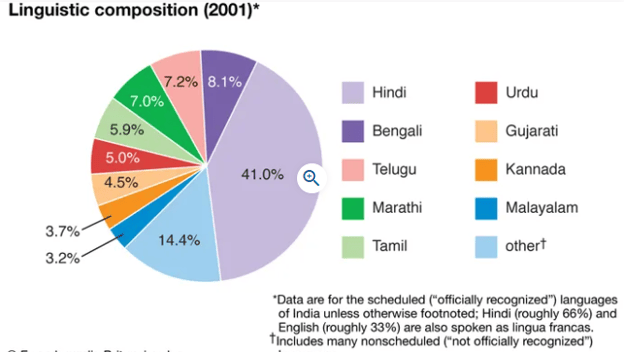Quick Summary: India’s diverse workforce brings creativity, flexibility, and a global view to IT outsourcing. Learn how cultural diversity boosts teamwork and innovation. Read our blog for comprehensive insights on how Indian talent turns challenges into opportunities.
India has a rich cultural diversity that goes beyond its vibrant traditions, languages, and festivals.
It is also about its global leadership in the IT outsourcing industry.
While considering Indian diversity, this cultural diversity fosters adaptability, innovation, and an unparalleled ability to collaborate across borders. It certainly makes India the preferred outsourcing destination for businesses worldwide.
In IT outsourcing, understanding cultural differences across India provides a significant advantage. It helps improve teamwork and aligns better with global business goals, which is vital for successful outsourcing partnerships.
Are you ready to explore how India’s cultural diversity enhances the IT outsourcing field? Read our complete blog and discover why businesses trust India for their outsourcing needs.
Key Takeaways
- India has a rich cultural diversity that leads to unique problem-solving and innovative ideas. Working with Indian IT professionals gives you access to a creative and adaptable talent pool.
- Indian IT professionals can bridge cultural gaps, which helps businesses collaborate smoothly across the globe.
- The multicultural environment in India has created a workforce skilled in working internationally. When you outsource IT services to India, you gain a global perspective and strong technical skills.
- The Indian IT outsourcing model takes advantage of time zone differences to provide 24/7 support. This approach improves operational efficiency that proceeds with the project even when your in-house team is offline.
- Outsourcing to India saves costs and delivers high-quality results driven by a workforce that values continuous learning and excellence.
What Is Cultural Diversity?
Cultural diversity means having different cultures, ethnicities, and backgrounds represented in a group or organization. It involves various perspectives and worldviews from different cultural traditions, values, beliefs, and practices.
In today's global economy, cultural diversity plays an important role in workplace culture. It brings fresh ideas and innovative solutions to complex problems by combining the unique experiences of people with different backgrounds.
Moreover, cultural diversity is not just about meeting quotas or checking boxes. It requires actively working to create inclusive environments where everyone feels welcome and valued for their contributions, regardless of their background.
A diverse workplace enhances creativity and personal growth by exposing employees to different viewpoints. This leads to higher job satisfaction and improved overall performance for the company.
Geographical Diversity
India has a vast geographical diversity. With landscapes ranging from snow-capped mountain ranges to plains, hills, and deserts, India has a wide variety to show. However, it brings a myriad of advantages to businesses seeking IT outsourcing solutions when it comes to geographical diversity as well.
Spanning from the 29 states to 8 union territories, the country's regional and cultural differences, the diversity of India has contributed to the improvement in business practices and operations through varied communication styles and work ethics.
In fact, the growing market size also shows the same as shown in the graph below:

Let us see how regional variations in India are transforming IT Outsourcing.
- North India is known for its robust technical pool and English proficiency. It's a hub for IT professionals who excel in tackling software development projects while maintaining effective international communication and project management.
- South India, having a gem like Bengaluru, is known for its strong expertise in emerging technologies like AI, ML, IoT, and more advanced software development technologies.
- West India, with regions like Mumbai and Pune, already the leading innovation-IT driven IT hubs that offer a mix of technical and creative talents,
- East India provides cost-effective solutions with professionals proficient in fields like customer support services and data analytics.
All in all, India offers a collaborative tech hub space that can be efficient and cost-effective for IT Outsourcing services. The diversity of Indian culture creates a dynamic ecosystem that adapts to the unique needs of global businesses.
Experience the Vibrancy of India’s Cultural Tapestry!
Hire global IT Experts to embrace innovation- where Cultural Intelligence Meets Tech Excellence
Linguistic Diversity and Communication
India's diverse languages are a valuable strength in IT outsourcing. India has around 122 languages, with over 22 official languages and more than 19,500 dialects, and a multilingual workforce. This workforce easily adapts to global communication needs. This ability makes India an ideal partner for businesses around the world, no matter what language they speak.
As per the 8th schedule of the constitution of India, there are 22 major recognized languages. These are Hindi, Assamese, Bengali, Gujarati, Kannada, Kashmiri, Konkani, Manipuri, Malayalam, Nepali, Marathi, Punjabi, Sanskrit, Tamil, Oriya, Urdu, Telugu, Sindhi, Boro, Santhili, Maithili, and Dogri.
Not only this, but there is a lot more to it.
India’s IT professionals are known for their strong English skills. It is the second-largest English-speaking country in the world. This mastery allows them to work well with clients in the US, UK, and other English-speaking areas. It also removes communication issues that could occur and facilitates cross-cultural teamwork.
According to NASSCOM, more than 80% of IT professionals in India have formal education or training in English communication. This training helps them work effectively on a global level.
Imagine working with a company that outsources IT services to India. You can benefit from developers who are skilled in coding and understand cultural differences and communication styles. This combination of technical skills and cultural awareness helps businesses create user-friendly solutions that are tailored to specific audiences.
Religious and Cultural Practices
India is home to many religions, including Hinduism, Islam, Christianity, Buddhism, and Sikhism. These beliefs influence people's values and behavior at work.
For instance, many IT professionals in India follow principles of discipline, hard work, and respect because of their religious teachings.
The religious diversity in India promotes harmony and balance. This helps create a dedicated and ethical workforce in IT outsourcing.
To work well with Indian outsourcing teams, it is important to understand religious and cultural differences. Understanding cultural diversity in India helps build trust and improves communication.
When businesses respect this cultural diversity of India, they can create stronger International collaboration and better teamwork. Recognizing cultural practices, such as taking breaks for festivals and adjusting to different communication styles based on roles, which allows companies to enjoy improved teamwork and collaboration.
- Increased employee motivation and productivity.
- Reduced turnover in outsourcing relationships.
- Long-term collaboration grounded in trust and respect.
Addressing Religious Practices & Festival Schedules for Enhanced Collaboration
Durga Pooja (West Bengal)
Christmas

Baisakhi (Punjab)

Major Festivals and Their Impact
India has a diverse culture that is highlighted through various festivals such as Diwali, Holi, Eid, and Christmas. These festivals not only showcase India's cultural charm but also affect business operations when working with Indian IT outsourcing partners.
Here’s how businesses can plan effectively while appreciating this Indian culture tradition and diversity:
Festival Calendar and Its Importance
Indian festivals often result in public holidays or shorter working hours. For example:
- Diwali (Festival of Lights): Many states observe 3–5 days of public holidays.
- Holi (Festival of Colors): This festival usually includes a holiday or half-day at work.
- Eid and Christmas: These celebrations also bring holidays or flexible schedules.
Festivals in India show the country's rich culture and help IT teams bond and stay positive. This boosts creativity and teamwork.
These celebrations also build stronger personal relationships among team members, leading to better collaboration and problem-solving. In fact, 74% of Indian employees say their productivity improves after festivals because they feel happier and more united with their teams.
By embracing these cultural events, businesses can create a motivated and connected team that is dedicated to delivering high-quality work. Understanding the festival calendar is crucial when outsourcing IT projects to India, as it helps ensure smooth project delivery without interruptions.
Holi

Diwali

Ganesh Chaturthi (Maharashtra)

Dussehra

Eid-Ul-Fitr

Chhath Puja (Bihar)

Losar Festival (Arunachal Pradesh)

Gangaur (Rajasthan)

Tips for Effective IT Outsourcing to India
India's culture and diversity give a strong advantage in IT outsourcing. The Indian workforce is known for its ability to adapt, innovate, and collaborate, which makes India a premiere destination for IT services. But how does this cultural diversity in India help in successful IT outsourcing? Here are ways businesses can benefit from it:
- Train Your Team on Culture: Help your team understand Indian work culture, communication styles, and holidays so that they can work together better.
- Use Local Contacts: Employ cultural liaisons to improve communication and make sure everyone is on the same page.
- Be Flexible with Scheduling: Plan for Indian festivals and holidays in your project timelines to keep work on track.
- Set Clear Communication Rules: Use collaboration tools and have regular check-ins for updates.
- Build Long-Term Relationships: Foster trust and loyalty by including outsourced teams in your business processes.


According to the Global Innovation Index 2024 rankings, India ranks 39th globally while remaining in 1st rank in the Central and Southern Asia regions.
When professionals from different backgrounds work together. India’s dual identity in innovation and tradition brings fresh skill sets, perspectives, and experiences to the table. This can lead to new ideation and problem-solving opportunities that wouldn't have been possible otherwise.
Myth 1: The decision-making process is complicated by cultural differences and miscommunication
#Fact: Having a diverse team leads to better decision-making. When team members come from different cultures, they offer various viewpoints. This helps the team consider more angles on important issues. In contrast, a group with similar backgrounds may miss important details. As a result, a team with diverse perspectives tends to make fairer decisions.
Myth 2: Indian teams have difficulty understanding global business standards
#Fact: Indian IT outsourcing companies are known for following international standards like ISO, GDPR, and CMMI. Over 75% of global outsourcing firms that meet ISO standards for data security are based in India.
Myth 3: Cultural challenges when collaborating with Indian teams.
#Fact: Cultural diversity in Indian tech teams creates new opportunities. When companies work with people from different backgrounds, they can better understand potential markets for their products. By learning about various cultural beliefs, organizations can adjust their communication strategies to connect more effectively.
Must Read: Tips to Streamline Communication With Offshore Team
Myth 4: Time zone differences make collaboration hard
#Fact: Indian IT teams use time zone differences to their advantage, offering services around the clock. This helps them provide faster development cycles and support for businesses worldwide.
Conclusion
India's cultural diversity is a source of pride and a key benefit for IT outsourcing. By embracing this diversity in Indian cultural values and traditions, businesses can bridge gaps, foster innovation, and achieve seamless collaboration.
At Your Team in India, we use our cultural insights in every IT outsourcing partnership. We provide solutions that are strong technically and aligned with your goals.
Ready to Experience Seamless IT Outsourcing?
Partner with Your Team in India to leverage the perfect blend of technical expertise and cultural understanding.









